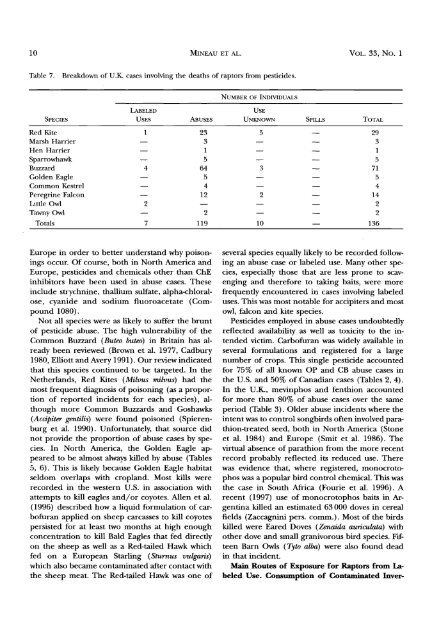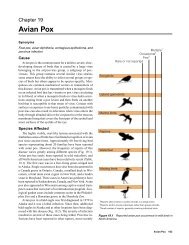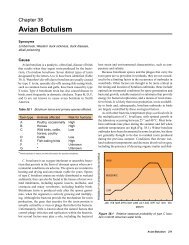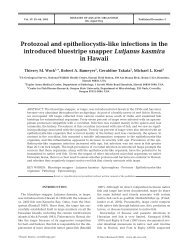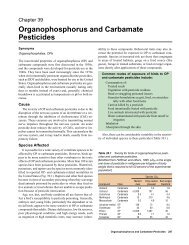poisoning of raptors with organophosphorus and carbamate ...
poisoning of raptors with organophosphorus and carbamate ...
poisoning of raptors with organophosphorus and carbamate ...
You also want an ePaper? Increase the reach of your titles
YUMPU automatically turns print PDFs into web optimized ePapers that Google loves.
10 M•EAu ET AL. VOL. $$, NO. 1<br />
Table 7. Breakdown <strong>of</strong> U.K. cases involving the deaths <strong>of</strong> <strong>raptors</strong> from pesticides.<br />
LABELED<br />
NUMBER OF INDIVIDUALS<br />
SPECIES USES ABUSES UNKNOWN SPILLS TOTAL<br />
Red Kite 1 23 5 -- 29<br />
Marsh Harrier -- 3 -- -- 3<br />
Hen Harrier -- 1 -- -- 1<br />
Sparrowhawk -- 5 -- • 5<br />
Buzzard 4 64 3 • 71<br />
Golden Eagle -- 5 -- • 5<br />
Common Kestrel -- 4 -- • 4<br />
Peregrine Falcon -- 12 2 -- 14<br />
L•ttle Owl 2 -- -- -- 2<br />
Tawny Owl -- 2 -- -- 2<br />
Totals 7 119 10 -- 136<br />
USE<br />
Europe in order to better underst<strong>and</strong> why <strong>poisoning</strong>s<br />
occur. Of course, both in North America <strong>and</strong><br />
Europe, pesticides <strong>and</strong> chemicals other than ChE<br />
inhibitors have been used in abuse cases. These<br />
include strychnine, thallium surfate, alpha-chloralose,<br />
cyanide <strong>and</strong> sodium fluoroacetate (Compound<br />
1080).<br />
Not all species were as likely to suffer the brunt<br />
<strong>of</strong> pesticide abuse. The high vulnerability <strong>of</strong> the<br />
Common Buzzard (Buteo buteo) in Britain has already<br />
been reviewed (Brown et al. 1977, Cadbury<br />
1980, Elliott <strong>and</strong> Avery 1991 ). Our review indicated<br />
that this species continued to be targeted. In the<br />
Netherl<strong>and</strong>s, Red Kites (Milvus milvus) had the<br />
most frequent diagnosis <strong>of</strong> <strong>poisoning</strong> (as a proportion<br />
<strong>of</strong> reported incidents for each species), although<br />
more Common Buzzards <strong>and</strong> Goshawks<br />
(Acdpiter gentilis) were found poisoned (Spierenburg<br />
et al. 1990). Unfortunately, that source did<br />
not provide the proportion <strong>of</strong> abuse cases by species.<br />
In North America, the Golden Eagle appeared<br />
to be almost always killed by abuse (Tables<br />
5, 6). This is likely because Golden Eagle habitat<br />
seldom overlaps <strong>with</strong> cropl<strong>and</strong>. Most kills were<br />
recorded in the western U.S. in association <strong>with</strong><br />
attempts to kill eagles <strong>and</strong>/or coyotes. Allen et al.<br />
(1996) described how a liquid formulation <strong>of</strong> carb<strong>of</strong>uran<br />
applied on sheep carcasses to kill coyotes<br />
persisted for at least two months at high enough<br />
concentration to kill Bald Eagles that fed directly<br />
on the sheep as well as a Red-tailed Hawk which<br />
fed on a European Starling (Sturnus vulgaris)<br />
which also became contaminated after contact <strong>with</strong><br />
the sheep meat. The Red-tailed Hawk was one <strong>of</strong><br />
several species equally likely to be recorded following<br />
an abuse case or labeled use. Many other species,<br />
especially those that are less prone to scavenging<br />
<strong>and</strong> therefore to taking baits, were more<br />
frequently encountered in cases involving labeled<br />
uses. This was most notable for accipiters <strong>and</strong> most<br />
owl, falcon <strong>and</strong> kite species.<br />
Pesticides employed in abuse cases undoubtedly<br />
reflected availability as well as toxicity to the intended<br />
victim. Carb<strong>of</strong>uran was widely available in<br />
several formulations <strong>and</strong> registered for a large<br />
number <strong>of</strong> crops. This single pesticide accounted<br />
for 75% <strong>of</strong> all known OP <strong>and</strong> CB abuse cases in<br />
the U.S. <strong>and</strong> 50% <strong>of</strong> Canadian cases (Tables 2, 4).<br />
In the U.K., mevinphos <strong>and</strong> fenthion accounted<br />
for more than 80% <strong>of</strong> abuse cases over the same<br />
period (Table 3). Older abuse incidents where the<br />
intent was to control songbirds <strong>of</strong>ten involved parathion-treated<br />
seed, both in North America (Stone<br />
et al. 1984) <strong>and</strong> Europe (Smit et al. 1986). The<br />
virtual absence <strong>of</strong> parathion from the more recent<br />
record probably reflected its reduced use. There<br />
was evidence that, where registered, monocrotophos<br />
was a popular bird control chemical. This was<br />
the case in South Africa (Fourie et al. 1996). A<br />
recent (1997) use <strong>of</strong> monocrotophos baits in Argentina<br />
killed an estimated 63 000 doves in cereal<br />
fields (Zaccagnini pers. comm.). Most <strong>of</strong> the birds<br />
killed were Eared Doves (Zenaida auriculata) <strong>with</strong><br />
other dove <strong>and</strong> small granivorous bird species. Fifteen<br />
Barn Owls (Tyto alba) were also found dead<br />
in that incident.<br />
Main Routes <strong>of</strong> Exposure for Raptors from Labeled<br />
Use. Consumption <strong>of</strong> Contaminated Inver-


